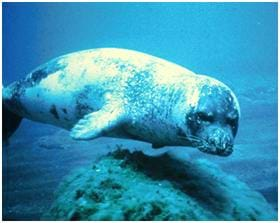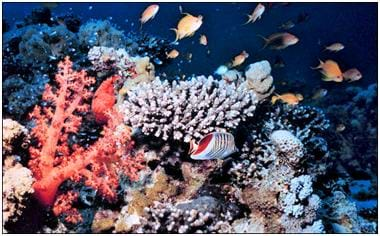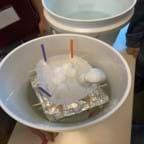Quick Look
Grade Level: 6 (5-7)
Time Required: 15 minutes
Lesson Dependency: None
Subject Areas: Biology, Life Science, Science and Technology

Summary
Species extinction is happening at an alarming rate according to scientists. In this lesson, students are asked to consider why extinction is a problem that we should concern us. They are taught that destruction of habitat is the main reason many species are threatened. The lesson explores ways that engineers can help save endangered species.Engineering Connection
Engineers can prevent extinction by developing ways to preserve diverse biological habitats. Materials engineers develop materials that mimic the qualities of wood to be used instead of rainforest timber. Chemical engineers have developed a way to lessen the harmful effects starfish have on coral reef. Environmental engineers are developing ways to combat global warming, which adversely affects coral reef. Agricultural engineers work to develop farming techniques that limit depletion of soil nutrients and maintain soil health. Engineers consult both the sciences and ethics issues as they shape their designs.
Learning Objectives
After this lesson, students should be able to:
- Understand why it is important to prevent extinction.
- List ways that engineering can prevent extinction.
- Evaluate competing solutions for maintaining biodiversity and ecosystem services.
Educational Standards
Each TeachEngineering lesson or activity is correlated to one or more K-12 science,
technology, engineering or math (STEM) educational standards.
All 100,000+ K-12 STEM standards covered in TeachEngineering are collected, maintained and packaged by the Achievement Standards Network (ASN),
a project of D2L (www.achievementstandards.org).
In the ASN, standards are hierarchically structured: first by source; e.g., by state; within source by type; e.g., science or mathematics;
within type by subtype, then by grade, etc.
Each TeachEngineering lesson or activity is correlated to one or more K-12 science, technology, engineering or math (STEM) educational standards.
All 100,000+ K-12 STEM standards covered in TeachEngineering are collected, maintained and packaged by the Achievement Standards Network (ASN), a project of D2L (www.achievementstandards.org).
In the ASN, standards are hierarchically structured: first by source; e.g., by state; within source by type; e.g., science or mathematics; within type by subtype, then by grade, etc.
NGSS: Next Generation Science Standards - Science
-
DCI.ESS3.C.6-8.3.
Human activities have significantly altered the biosphere, sometimes damaging or destroying natural habitats and causing the extinction of other species. But changes to Earth's environments can have different impacts (negative and positive) for different living things.
(Grades 6 - 8)
More Details
Do you agree with this alignment?
-
DCI.LS2.C.6-8.3.
Biodiversity describes the variety of species found in Earth's terrestrial and oceanic ecosystems. The completeness or integrity of an ecosystem's biodiversity is often used as a measure of its health.
(Grades 6 - 8)
More Details
Do you agree with this alignment?
International Technology and Engineering Educators Association - Technology
-
Explain how knowledge gained from other content areas affects the development of technological products and systems.
(Grades
6 -
8)
More Details
Do you agree with this alignment?
State Standards
Colorado - Science
-
Changes in environmental conditions can affect the survival of individual organisms, populations, and entire species
(Grade
6)
More Details
Do you agree with this alignment?
Pre-Req Knowledge
It may be helpful for students to have some background in global warming and in biodiverse habitats or biospheres, such as rainforests, marshes, and coral reefs. It would also be useful for students to have an understanding of food webs, which demonstrate the interdependency of plants and animals in an ecosystem.
Introduction/Motivation
What does it mean for a species to become extinct? (Answer: It means that those plants or animals have completely died out, and no longer exist on Earth.) Good answers! Scientists claim that species are going extinct every day, by the hundreds. In the rainforest alone, it is estimated that there are about 50,000 species going extinct each year. Why should we care about extinction? (Solicit responses. Refer to background information for possible answers.)
How can we prevent it? If we can put a stop to the destruction of natural habitats, this will go a long ways towards avoiding species extinction. Habitats may be threatened in a number of ways: rainforests can be destroyed by clear cutting, which is the practice of cutting down all trees in a large area of forest; and coral reefs and polar ice caps are two habitats that are threatened by rising temperatures and other effects due to global warming. How can engineers make a difference? Refer to the News Flash! activity to have students create an imaginary TV broadcast that explains how engineers, and the scientists who help them, have saved an imaginary species of their choice.

What are engineers doing to save natural habitats and prevent extinction? As part of the design process, engineers listen to environmental scientists to gather information that will help them design products to fight extinction. For example, some scientific studies have shown that greenhouse gas emissions have contributed to global warming, which in turn could endanger some plants and animals. Using this scientific evidence, engineers can design products (like cars) that reduce harmful emissions as a way of reducing the risk of extinction. Engineers create both direct and indirect solutions to prevent extinction: materials engineers are developing long-term alternatives to wood; architectural engineers are making buildings more energy efficient; mechanical and chemical engineers are producing clean energy; and civil and other engineers are working to save coral reefs.
Techniques developed and intended to reduce strain on the biosphere in one area may have unintended detrimental effects on another area. One example of this is begins with the development of pesticides by agricultural and chemical engineers. By using pesticides, farmers were able to drastically reduce the loss of crops due to insect destruction, significantly improving crop yields and reducing the required size of farm land, limiting farm expansion into the wilderness. However, overuse of pesticides is attributed to colony collapse disorder (CCD) in bees, which are primarily responsible for pollinating many of our crops, which reduces crop yield. From this example, it is clear that there are competing factors in ecological conservation, which needs to be balanced to produce the best possible results.
Lesson Background and Concepts for Teachers
Extinction and Biodiversity
Animal and plant species are becoming extinct at an alarming rate. It has been estimated that in the rain forests alone, over a hundred plant, animal and insect species are lost each day, which translates to 50,000 species a year. The most biologically diverse areas of the world tend to see the greatest species extinction. Hence, the rainforest and coral reef, known as the "rainforest of the sea," tend to be at the center of many researchers' concern. Overwhelming evidence suggests that the loss of biodiversity in these habitats is a direct cause of plant and animal extinction. Here are a few reasons that could be cited for preventing extinction of a species:
- Curative medicine: Biodiverse habitats provide us with valuable resources, such as pharmaceuticals that are derived from plants. Some scientists postulate that the rainforest may contain substances that could help treat cancer, prevent HIV, or cure Multiple Sclerosis.
- Biodiversity and ecological stability: If a particular plant or animal species goes extinct, this will affect all food chains that species belongs to, and eventually the food web. A healthy, diverse ecosystem is shown to be better at preserving soil nutrients, maintaining good water quality, breaking down organic waste and buffering against extreme regional climate change.
- Aesthetic: Biodiverse places have a natural beauty that we should preserve.
- Ethical: Every living thing has a right to live.
Many types of engineers work on creating products that help save plants and animals. For example, material engineers can develop new building supplies that mimic wood in function (such as structural support), form (the way it looks) and cost. If engineers are successful, then the need for actual timber in the rainforest should diminish. This can reduce the harmful practice of clear cutting rainforest timber, which destroys precious habitat for many plants and animals. Some engineers are working on saving coral reefs and the diverse animal and plant life that depend on them. Coral reefs are destroyed in a number of other ways: pesticide and nutrient runoff encourages the growth of algae that smothers coral, which needs sunlight to survive; industrial toxins are dumped into the ocean and poison coral; and careless construction, logging and farming all lead to erosion which smothers and kills coral. Civil and agricultural engineerscan play a role in the prevention of coral death by encouraging better farming practices which reduce pesticide runoff and control erosion, and environmental engineers can develop a more responsible way of handling industrial waste. Coral reefs are also threatened by an overpopulation of starfish, which feed on coral, and are overwhelming their own food source. Chemical engineers in Japan have isolated a chemical produced by sea urchins that attracts starfish. Using this chemical, the starfish is attracted away from the coral and relocated to other places in the ocean or exterminated.
Engineers are indirectly helping to preserve habitat through combating global warming. The phenomenon of global warming may be alleviated as engineers develop new methods to help our society use less energy (gas and electrical) and use more clean energy (energy produced in a way that does not contribute to global warming, such as wind, solar, and biomass). Engineers do not necessarily have coral reef or the rainforest in mind when they are doing this work, but nonetheless these biodiverse habitats benefit from lack of human intervention, and the ensuing stability in their habitats.
Associated Activities
- News Flash! - Students create an imaginary TV broadcast that explains how engineers, and the scientists who help them, have saved an imaginary species of their choice.
Lesson Closure
For practical, ethical and aesthetic reasons, it is important that we try to prevent endangered plants, animals and instincts from going extinct. Engineers from a wide variety of disciplines are working on developing products that can help protect the habitats in which those endangered species live.
Vocabulary/Definitions
biodiverse: Describes a habitat that has many different types of plants, animals and insects.
endangered: Having the possibility of becoming extinct.
extinction: A species of plant, animal or insect has completely died out and no longer exists.
species: In the classification of living things (e.g., plants, animals and insects), this is the most specific level of classification.
Assessment
Pre-Lesson Assessment
Discussion Topic: Ask students to share stories about a pet that has passed away. How did it make them feel? What if that type of pet no longer existed at all, so that they could not even go to the pet store to buy another one? What are their reactions to that hypothetical situation? What if your pet were one of the last few animals of its kind? What would you do to save the species?
Post-Introduction Assessment
Draw a Cartoon: Have each student take out a piece of paper and pencil. They should draw a cartoon that demonstrates an understanding of what extinction is, why we would want to prevent endangered animals from going extinct, and what engineers are doing to help.
Discussion Topic: Ask students to think of different techniques (including practices that are already in use, becoming developed, or may not exist yet) we employ (or could employ) to reduce our impact on the environment and mitigate habitat destruction. Ask students to discuss the costs and benefits associated with these practices.
Lesson Summary Assessment
TV News Blurb: Have students pretend that they are introducing a news report on an endangered species that describes what engineers are doing to save the species. For example, they could say, "Next, up, we'll look at a story on polar bears, an animal that is endangered due to melting ice caps. Some environmental engineers are working to save these animals by designing a unique strategy to lower greenhouse gases to keep our Earth cool."
Lesson Extension Activities
Have students write letters to their Congress representative on topics related to extinction. For example, they could ask, "What steps are being taken to curb global warming?" or "Are the forests and natural habitat in my state being preserved?" Have students think of an animal they believe is soon-to-be extinct. Have them research why it is endangered and determine what might be done to help save the species. Their work could be presented to the class or submitted in a written report.
Subscribe
Get the inside scoop on all things TeachEngineering such as new site features, curriculum updates, video releases, and more by signing up for our newsletter!More Curriculum Like This

This unit covers the processes of photosynthesis, extinction, biomimicry and bioremediation. In the first lesson on photosynthesis, students learn how engineers use the natural process of photosynthesis as an exemplary model of a complex yet efficient process for converting solar energy to chemical ...

Students are presented with the phenomenon of human activities killing coral reefs. They work in groups of 2-5 to create a prototype to help reduce the impact of coral loss from an assigned perspective (e.g., coral bleaching, tourism, pollution, overfishing/dredging). They should already have basic ...
References
National Oceanic and Atmospheric Administration, United States Department of Commerce, National Marine Fisheries Service, accessed March 12, 2009. http://www.nmfs.noaa.gov/pr/images/pinnipeds/mediterraneanmonkseal_ifaw.jpg
Riebeek, Holli. National Aeronautic and Space Administration, Earth Observatory, Paleoclimatology: Climate Close-up, December 22, 2005, accessed March 12, 2009. http://earthobservatory.nasa.gov/Features/
Copyright
© 2009 by Regents of the University of Colorado.Contributors
Michael J. Bendewald; Karen King; Janet YowellSupporting Program
Integrated Teaching and Learning Program, College of Engineering, University of Colorado BoulderAcknowledgements
The contents of this digital library curriculum were developed under a grant from the Fund for the Improvement of Postsecondary Education (FIPSE), U.S. Department of Education and National Science Foundation GK-12 grant no. 0338326. However, these contents do not necessarily represent the policies of the Department of Education or National Science Foundation, and you should not assume endorsement by the federal government.
Last modified: March 10, 2022







User Comments & Tips